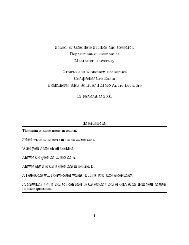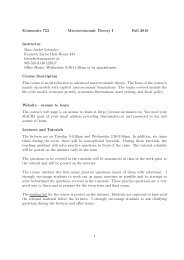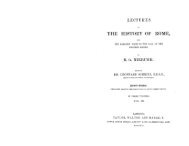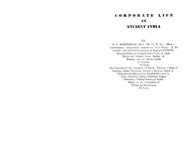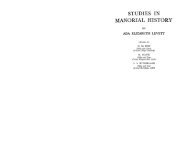PART 111.WRITINGS, OPINIONS, AND CHARACTER OF SIR JOHNFORTESCUE.Fortescue WE must now turn from Fortescue tlie lawyer, the judge,as a writer. the ardent <strong>an</strong>d faithful adherent of the L<strong>an</strong>castri<strong>an</strong> cause,to Fortescue the publicist <strong>an</strong>d writer. But the political<strong>an</strong>d the literary activity of Fortescue are closely connected.It was in the service of the house of L<strong>an</strong>caster that he firstIlivisions wielded both sword <strong>an</strong>d pen. His writings may be dividedof his writings.according to their subject into three classes :-l. Works onthe dynastic question of the rival claims of the houses ofL<strong>an</strong>caster <strong>an</strong>d York. 2. Constitutional Treatises. 3. Miscell<strong>an</strong>eouswritings.<strong>The</strong> first class comprises several short tracts on theSuccession question, <strong>an</strong>d the second book of the treatiseDe Natzird Legis Natzi~.~~. <strong>The</strong> second class comprises tbefirst book of that treatise, the De Latldib~is Legzinz A~zglic,<strong>an</strong>d the present work. <strong>The</strong> third class comprises onegenuine tract <strong>an</strong>d some others 'L, which the authenticity is,I think, extremely doubtful.Tracts 011 <strong>The</strong> class which I have placed first is also in the main thethe Sncces- first in order of composition. In it the first place belongsto the short tracts which Fortescue wrote in favour of theL<strong>an</strong>castri<strong>an</strong> Title. Of these there have come down to us,either in whole or in part, the following :-I. De Titzilo Edwardi Cognitis Marchiczl. (Latin. Complete.)2. Of the Title of the House of York2. (English.Fragmentary.)3. Defensio Yt'lrris Donztts L<strong>an</strong>casl'Yicz3. (Latin. Fragmentary.)4. A Defence of the House of L<strong>an</strong>caster: otherwisel Works, pp. 63"-74". MS. Cotton. Vesp. F. ix. f. 122.lb. 497-502. In Appendix D <strong>The</strong> tract is still however incom-I have printed what I believe to be plete.tlie beginning of this tract from Works, pp. 505-510.called, A replication to the claim of the Duke of York1.(English. Complete.)In the tract which he afterwards wrote to refute his own Otherwritingsarguments, Fortescue says that there were m<strong>an</strong>y writingsmade in Scotl<strong>an</strong>d by other men which were fathered upon Successionquestion.him without his consent <strong>an</strong>d knowledge; others were drawnup by Henry's council, <strong>an</strong>d passed by a majority of votes,though to some of them he himself was ' not well willing.'Others were his own composition2. Among the workswhich Fortescue denies to have been his was one embodyingthe absurd story, first set about at the time when Johnof Gaunt was thought to be aiming at the succession,that Edmund Crouchback was really the elder brother ofEdward 13. It is to Fortescue's credit that he rejects thisfable. But, on the other h<strong>an</strong>d, he had no motive for acceptingit. Any claim derived from Edmund Crouchback musthave come through Bl<strong>an</strong>che of L<strong>an</strong>caster, the wife of Johnof Gaunt, <strong>an</strong>d the whole of Fortescue's argument rests onthe exclusion of all claims derived through females4. <strong>The</strong>reis however no reason to doubt the authenticity of <strong>an</strong>y ofthe four tracts enumerated above. <strong>The</strong>y are consistentwith one <strong>an</strong>other, <strong>an</strong>d with what we know from othersources to have been Fortescue's views, <strong>an</strong>d the argumentswhich they contain are those which are refuted in his subse-quent rec<strong>an</strong>tation. Rut the fact that they <strong>an</strong>d also thesecond part of the De Nntzrvd Lcgis Natzlre have only' Works, pp. 517-8, under the again (p. 4) says that there wasformer title ; below, Appendix C, <strong>an</strong> idea of marrying Edward IV'sunder the latter. This tract seems eldest daughter to the son ofclearly referred to in the ' De- Warwick's brother Montague ;claration,' &C., Works, p. 536. 'whiche, by possibylite, shuld belb. 523-4. kynge of Englonde.' Fortescue'sS Capgrave however accepted views are however confirmed byit. See Illustr. Henr., pp. xv, <strong>an</strong> entry on the Close Roll of 13107. Hen. 111, memb. I 5, dorso : ' non* That the idea of female suc- est consuetudo vel lex in terracession was not wholly str<strong>an</strong>ge nostra Angli~, quod filia fratrisin Engl<strong>an</strong>d at this time is proved alicujus primogeniti fratrem jubythe charges against Suffolk niorem patri sbo succedentemof intending to marry his son to hzreditarie super haereditate suaMargaret Beaufort with a view possit vel debeat impetere ;' citedto the succession to the crown; by Hardy, Preface to Close Rolls,Rot. Parl. v. 177 b. Warkworth p. xxxvi.
Other come down to us for the most part in single copies', makestracts ofFortescue it extremely probable that Fortescue wrote other fugitiveprobably pieces on the same subject which have perished2. Underlost.the repressive <strong>an</strong>d inquisitorial system which Edward IVestablished after his restoration it was no doubt d<strong>an</strong>gerousl <strong>The</strong> only known copy of both We are not left wholly to conpartsof the De Naturd Legis jecture on this point. In theNatzwe is the Lambeth MS. 262. De TituZo Edwardi, &C., For-A copy of the first part, which tescue speaks of 'codicem illumdoes not trench upon the Suc- ariginalem qui de hiis latiu;cession question, is among the continet in vulgari scriptum ;Laud MSS., No. 585. <strong>The</strong>re was Works, p. 63". This might bea copy of this work among the the English tract on the TitleWorsley MSS. (see Catalogus of the House of York (No. 2,Librorum M<strong>an</strong>uscriptorum, ii. above), but I have given reasons213 a), but whether this con- lower down for thinking that thattained both parts or not I c<strong>an</strong>not is later, not earlier, th<strong>an</strong> the Desay. Of the other tracts mentioned Titulo Edw. Again, at the endin the text, No. I exists only in of the latter Fortescue <strong>an</strong>nouncesthe Yelverton MS., vol. 69. <strong>The</strong> his intention of compiling <strong>an</strong>otherfragments of No. 3 come from work on the subject, \vhich wastwo sources, but both are derived to embody certain documents ;from the one copy which perished Works, pp. 73" f. This workin the Cottoni<strong>an</strong> fire. Nos. 2 <strong>an</strong>d also, if it was ever written, has4 are partial exceptions to the rule. not been found. Of the cause ofNo. z was prrnted by Lord Cler- this scarcity there c<strong>an</strong> be no doubt,mont from MS. Cotton, Julius F. when we compare the numerousvi. <strong>The</strong>re is <strong>an</strong>other copy in copies which exist of the oneMS. L<strong>an</strong>sdowne 205, f. 137. A fact which Fortescue wrote inpreliminary note, dated 1581, I iour of the House of York.states that it was copied from hesides the five MSS. enumerated' certayne leves of a booke . . . . by Lord Clermont (Works, p. ~zo),found in a bookbynder's shoppe, I have come across the following :wheras the said book ignor<strong>an</strong>tly two copies in the Yelverton MSS.,had been putt to prof<strong>an</strong>e uses.' vols. 21 <strong>an</strong>d 86 ; a second copyThis copy corlesponds exactly (besides the one cited by Lordwith the Cottoni<strong>an</strong> MS., so that Clermont) in MS. Harlei<strong>an</strong>, 1757 ;either the latter contains the <strong>an</strong>d MS. Digby? 198, which last' leves ' in question, or both MSS. is the most <strong>an</strong>crent of all, but iscopied the same ' leves.' Of unfortunately incomplete. HowNo. 4 I have found one complete much the insecurity of the timecopy among the Yelverton MSS., contributed to the destruction of<strong>an</strong>d there 1s <strong>an</strong> incomplete copy papers &c. may be seen from thein the Phiuips collection. Not frequent requests made by corhavingseen the latter I c<strong>an</strong>not respondents that their letters ]naysay whether it is derived from the be destroyed as soon as read ;former. It is the one which Lord cf. Rymer, ix. 680 ; Paston Let-Clermont has printed. Stone ters, i. 229, 346, 396, 433 ; iii. 487 ;has made two tr<strong>an</strong>scripts of the Uekynton, i. 268. Another symp-Yeherton copy : Harl. 543, f. 163, tom of the time is the number<strong>an</strong>d Harl. 545, f. 136. But all these of <strong>an</strong>onymous letters ; see Pastonhave escaped Lord Clermont. Letters, iii. 515.to be found in possession of tracts which favoured theclaims of the house of L<strong>an</strong>caster. Of these four tracts the Characterlast is only a short piece intended to prove the illegitimacyof Philippa the reputed daughter of Lionel Duke of tracts.Clarence, through whom the line of York derived theirclaim, a point which is also discussed, though more briefly,in the first two pieces. <strong>The</strong> first three all cover much thesame ground, <strong>an</strong>d by tabulating their contents <strong>an</strong>d comparingthe refutation of them in the 'Declaration uponcertain Writings' we could restore with <strong>an</strong> approach tocertainty the missing parts of Nos. 2 <strong>an</strong>d 3. <strong>The</strong>se lastare practically identical with one <strong>an</strong>other, one being inLatin <strong>an</strong>d the other in English. It is impossible to saywhether the English or the Latin version was composedfirst. But there c<strong>an</strong> be little doubt that No. I is the earliestof the group, both because the arguments there broughtforward are much less elaborated th<strong>an</strong> in the correspondingportions of the other tracts, <strong>an</strong>d also because it containsinaccuracies which are corrected in the latter l. To the <strong>The</strong> secondsame class belongs, as I have said, the second part of the g2di,hkDe Nattrrd. Legis Natzwa. <strong>The</strong> difference <strong>between</strong> it <strong>an</strong>d Legis Nuthepreceding tracts consists, not only in its greater length '"m'(it occupies seventy large quarto pages in Lord Clermont'sedition), but in the fact that while they deal openly <strong>an</strong>davowedly with the concrete case of the English Successionas disputed <strong>between</strong> the houses of York <strong>an</strong>d L<strong>an</strong>caster, thisis in form purely abstract. It is cast into the shape of<strong>an</strong> argument, conducted before Justice as judge, <strong>between</strong>' Thus in the Dc: Titulo Ed- through whose marriage withwar&, c. 3, Fortescue makes hlortimer's sister Ann the claimsPvZargaret, wife of Malcolm C<strong>an</strong>- of the Mortimers passed to themore, the daughter of Edrnund House of York. This on~issionIronside. In the nefensio he (it is not a mistake) is suppljedmakes her rightly 111s gr<strong>an</strong>d- in the 'Title of the House ofdaughter ; Works, p. 506. Again, York,' Works, p. 500; <strong>an</strong>d in thein the Be TituZo, c. 13, Fortescue Defensio ; ib. 509. <strong>The</strong> date offrom Edmund Mortimer Earl of the De TituZo is approximately.March passes immediately to fixed by the mention ,of LouisRichard Duke of York, omitting XI as 'nuper unctus ; ib. 74*.all notice of the latter's father, Louis XI was crowned August I 5,Richard Earl of Cambridge, 1461.
- Page 1 and 2: OTHER WISE CALLEDThe Difference bet
- Page 3 and 4: THE work here presented to the read
- Page 5 and 6: preface. preface, xihistorical bear
- Page 7 and 8: NOTE.-AS a general rule the authori
- Page 9 and 10: xviii CLbconological Cable, QLbrono
- Page 11 and 12: INTRODUCTION.PART I.TIIE fifteenth
- Page 13 and 14: Key-note ' The key-note of the Lanc
- Page 15 and 16: 3(n troduction,His reign only as de
- Page 17 and 18: directed, and they must therefore b
- Page 19 and 20: crimes from punishment'. This evil,
- Page 21 and 22: Perversionof justice.Localoffice1 S
- Page 23 and 24: Influence use their local power to
- Page 25 and 26: houses of Parliament an oath agains
- Page 27 and 28: Tumber of action lay1. One cause of
- Page 29 and 30: The House been judged in history fo
- Page 31 and 32: does not involve the acquittal of t
- Page 33 and 34: life as ahnrrister.become possessed
- Page 35 and 36: ford Castle a prisoner named Thomas
- Page 37 and 38: Anarbitra- Wentworth and Sir John F
- Page 39 and 40: The Lancastriansretirenorthwards.Ag
- Page 41 and 42: which they said was ruining the cou
- Page 43 and 44: Illterview way alone. At Bdthune th
- Page 45 and 46: feelings the exiles received the ne
- Page 47: Requiredto write infavour ofthe Yor
- Page 51 and 52: And moche good truly gotyn hath bee
- Page 53 and 54: Date.The DeI.arrcfi6usLegurnA uglii
- Page 55 and 56: The RIS. is well and correctly writ
- Page 57 and 58: cording to Mr. Thompson, is of the
- Page 59 and 60: I'robably On the whole, the second
- Page 61 and 62: Aquinas, six I have failed to trace
- Page 63: Fortescue'scontemporaries.Littleton
- Page 66 and 67: sithpn thai had a kynge, wich was G
- Page 68 and 69: that cause and for gret necessite w
- Page 70 and 71: such meane. And yet of necessite th
- Page 72 and 73: and sqviers, and oper, in also gret
- Page 74 and 75: or by lande, pe kyng most encomptre
- Page 76 and 77: grettest lordes off Englond, rose a
- Page 78 and 79: as hynl liste. And by discente per
- Page 80 and 81: haue wherwith to bie hem bowes, arr
- Page 82 and 83: Ther is no man hanged in Scotlande
- Page 84 and 85: e kyng be counsellyd to restrayne g
- Page 86 and 87: pe Romans, but also is hyghnes shal
- Page 88 and 89: muned and del~bered with his fforsa
- Page 90 and 91: CRITICAL NOTES.CHAPTER I.P. 109. 1.
- Page 92 and 93: Bfbe bobernance of QEnfiian'tr,CHAP
- Page 94 and 95: 1. 24. parcial] parcialite L (from
- Page 96 and 97: for granting taxes was the same as
- Page 98 and 99:
moral philosophy, but consists of a
- Page 100 and 101:
are brought about by the sin of man
- Page 102 and 103:
note$+ QLbap. ii,regendo: non autem
- Page 104 and 105:
note$+ CCbap, ii,up in the most une
- Page 106 and 107:
Later statutes fixed the limit of l
- Page 108 and 109:
&be bobernanre of QEngIanD*applied
- Page 110 and 111:
of the household of George Duke of
- Page 112 and 113:
RgidiusRumanus.. . . homines sibi s
- Page 114 and 115:
note see Janet, i. 35 1-373, 396,42
- Page 116 and 117:
'Ordinaryand extraordinaryexpenditu
- Page 118 and 119:
p----p---3723ESTIMATED EXPENDITURE.
- Page 120 and 121:
pestifera.' Very possibly Fortescue
- Page 122 and 123:
i the clerkys off theschekquer.] Be
- Page 124 and 125:
eciting how 'the seid Duc . . . lat
- Page 126 and 127:
was defined by Parliament in 4 Edwa
- Page 128 and 129:
punish ' piratas et spoliatores mer
- Page 130 and 131:
marchandyse is lost, . . . the see
- Page 132 and 133:
Transition pensiononmg, as it was d
- Page 135 and 136:
@Lbap+ bii,commiscomissioners in gr
- Page 137 and 138:
ap1-0,Bterc,cjzt4IjAnd on the other
- Page 139 and 140:
Charleshlartel.Fall of theCarolingi
- Page 141 and 142:
the Abbey of S. Albons' (July: Past
- Page 143 and 144:
York, married Constance and Isabell
- Page 145 and 146:
Taxon France, ii. 526, 533-4, 547,
- Page 147 and 148:
499 b). And no less than ~o,ooo mar
- Page 149 and 150:
which was probably in Fortescue's m
- Page 151 and 152:
holders of such grants are however
- Page 153 and 154:
286 Cbe Booernance of Qngianb.exter
- Page 155 and 156:
teristic of the Lancastrian times,
- Page 157 and 158:
such a contenuall counsell.] ' The
- Page 159 and 160:
character which the council might p
- Page 161 and 162:
which can not counsele hym' (Append
- Page 163 and 164:
306 &be bobernance of QEnglanD.'whe
- Page 165 and 166:
Sicque horum mediis concessit tande
- Page 167 and 168:
Ebe bobernance of QEngland.qualific
- Page 169 and 170:
Controlof the exchanges.Jealousyof
- Page 171 and 172:
during good behaviour. The Master o
- Page 173 and 174:
Cbe Qiobernance of QEngIand,says: '
- Page 175 and 176:
should be Justice, Chamberlain, Cha
- Page 177 and 178:
Offices per- system of executing of
- Page 179 and 180:
Defined by (e.g. Rot. Parl. v. 2 73
- Page 181 and 182:
have been detailed in the notes to
- Page 183 and 184:
of Sir Harris Nicolas there). This
- Page 185 and 186:
iiij. lordis temporelx, or in lasse
- Page 187 and 188:
y a pretensed title, saying he ys d
- Page 189 and 190:
'every broker, brogger, andhuckster
- Page 191 and 192:
suffre, suffer, 152. 14 ; soeffre,
- Page 193 and 194:
Cade, rising of, pp. 11, 284; hisco
- Page 195 and 196:
~ .-.~--hopes entertained of him, p
- Page 197 and 198:
Franchise, question of, in medizval
- Page 199 and 200:
Loans raised by the government,pp.
- Page 201:
Pisa, Council of, p. 243. .Pitt, se



